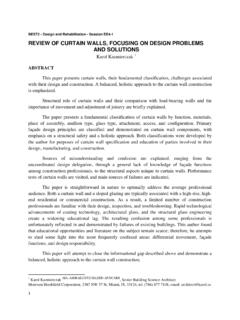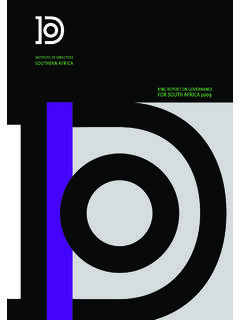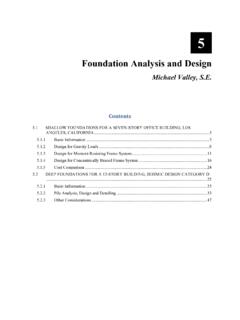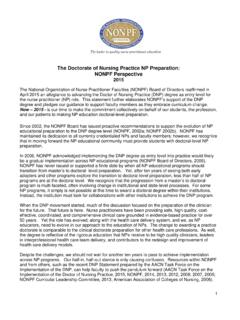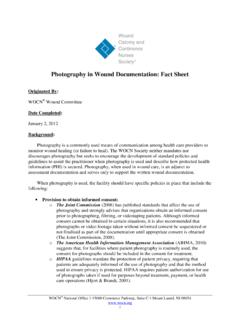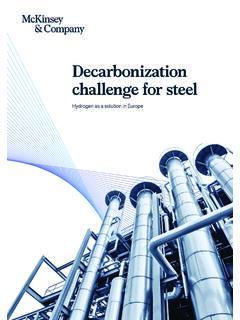Transcription of How to Estimate the Cost of a Steel Superstructure for a ...
1 Page 1 How to Estimate the Cost of a Steel Superstructure for a Multi-Story Medical Office Building at Design Development CPE Candidate No. 0113008 June 2013 Page 2 Table of Contents Section 1 Introduction Page 3 Section 2 Types and Methods of Measurements Page 4 Section 3 Special Factors to Consider that May Affect Takeoff and Pricing Page 6 Section 4 Overview of Labor, Material, Equipment, Indirect Costs & Markups Page 8 Section 5 Special Risk Considerations Page 9 Section 6 Ratios & Analysis Page 11 Section 7 Miscellaneous Pertinent Information Page 12 Section 8 Sample Drawings Page 13 Section 9 Sample Take-off & Estimate Workup Page 15 Section 10 Terminology / Glossary Page 17 Section 11 References Page 18 Page 3 Section 1 - Introduction The purpose of this technical paper is to express to the reader a basic understanding of how to Estimate the cost of a Steel Superstructure for a multi-story medical office building.
2 Specifically, the focus will be on a building in the design development stage, where special considerations and assumptions must be taken into account while preparing the Estimate due to undeveloped design information. This paper will focus on how to perform quantity takeoffs of Steel beams, columns, miscellaneous connections and composite floor and roof decking. This paper will not focus on or address tube Steel , joists and trusses, stair towers or cementitious spray-fireproofing and intumescent fireproofing. This paper will also provide directions on calculating appropriate secondary quantities such as Steel tonnage, as well as working up ratios to confirm that the takeoff and quantities make sense given the building and use-type. CSI s 2004 MasterFormat edition has been used. Main CSI Divisions: 030000 Concrete 050000 Metals Main CSI Subdivision: 033000 Cast-in-Place Concrete 050100 Maintenance of Metals 050500 Common Work Results for Metals 051200 Structural Steel Framing 053100 Steel Decking Brief Description A structural Steel framed building is a good choice for many reasons.
3 Steel is a very strong material with a high strength to weight ratio, and as it is shop fabricated, it lends itself to maintaining tight tolerances. Page 4 Steel framed buildings also give designers and engineers flexibility when it comes to design and layout, while also giving the owner a range of options depending on their needs. Steel beams and columns are the main components of almost all structural Steel frames, and are used to carry and distribute loads for the entire building. Steel decking is used for floors, usually in conjunction with a concrete topping. Such a system is known as composite decking. Steel decking is also used for the roof deck, though typically not with a concrete topping, unless a heavier than usual load is anticipated, sometimes for things such as a green roof or for future vertical expansion. There are different types of connections, either bolted or welded, and various types of miscellaneous Steel plates, bracings, angles and channels that will complete the system.
4 Usually at the design development stage, the designers do not have all of these details developed yet, so the estimator must make allowances for such items that they know will be needed but aren t specifically called out for yet. This is where the use of proven ratios and evaluation by the estimator against historical data is critical to making a good judgment on the quality and accuracy of the Estimate . Also, it provides the estimator a chance to provide feedback to the design team as to potential challenges or issues that could arise. Section 2 Types and Methods of Measurement Structural Steel buildings, in particular medical office buildings, have a somewhat standard design concept that must be developed by the engineers. Column spacing must be developed, and in conjunction with the floor-floor height the engineers must develop Steel members that will support and carry the building s anticipated loads.
5 By understanding the loads for different building types, the estimator can begin to develop a confident and reliable Estimate at the design development stage of design. The level of detail available depends on the design team and the submittal, however typically by this point the columns and grid will be laid out, with initial beam and column sizes being determined. The floor-floor heights will also be known at this point, so obtaining accurate quantities should be Page 5 expected. The estimator can now determine quantities of different beam and column types, such as wide flange (W) beams and columns, tube Steel (HSS) beams and columns, angles (L), channels (C), and other miscellaneous types used in a variety of situations. A typical wide flange beam or column will be referenced by its nominal height in inches, as well as the weight per linear foot.
6 For example, a W21x44 denotes at beam that is nominally 21 inches high and weighs 44 pounds per linear foot. Standard tables, such as those found in the AISC Manual of Steel Construction, are used to determine weight per linear foot for other miscellaneous shapes such as angles (L) and tube Steel (HSS). Steel floor and roof decking is measured in square footage, using either traditional manual takeoff methods, or using an electronic plan digitizer such as On-Screen Takeoff. An allowance is typically made for miscellaneous connections and undefined Steel members that can reasonable be assumed at this stage of design. Structural Steel is taken off in pounds and typically priced in tons. The ratio analysis workups are easier undertaken and scrutinized in pounds. The formula and conversions for takeoff are: Weight (Ton) = Length x Weight / 2,000 Length = Length of Beam, Column, Misc.
7 Steel Member Weight = Weight of Beam, Column, Misc. Steel Member per Linear Foot 2,000 = Conversion factor of Pounds to Tons Floor and Roof Decking Area* = Length x Width Length = Length Dimension of Building Width = Width Dimension of Building *if not a square or rectangular shape, typically is measured by electronic takeoff software for accuracy Typically by design development, the plans and details will be developed enough to show the layout of structural columns and major beams/girders, and most items should show member sizes. There may or may not be secondary framing shown, and if so it may or may not have sizes shown. The design at this point will probably not have all framed openings, mechanical support framing, moment connections or Page 6 other special considerations developed as of yet. This is ok, as the estimator will use rules of thumb and historical data to fill in these gaps to produce their Estimate .
8 All Steel members known will be quantified by total linear footage based on the plans and column schedules (if available). Section 3 Special Factors to Consider that May Affect Take-off and Pricing Small Quantities Vs. Large Quantities This concept applies to most all trades and is not unique to structural Steel , however smaller projects with less tonnage will tend to cost higher than a larger project with significantly larger quantities. There are costs such as mobilization and setup that are required regardless of overall tonnage. The unit rates are impacted on different sized jobs because on larger projects those costs are more spread out and absorbed into applied unit rates. The installed unit rate per ton on a 400 ton project will cost less than the installed unit rate per ton on a 50 ton project. Geographical Location Regional differences in materials, labor and equipment can all have an impact on overall costs.
9 For example, wage rates for labor in New York, NY will tend to be much higher than in Tampa, FL. There can also be differences due to availability of natural resources and materials, as well as manpower. It can all depend on how hot the construction market is at any given time in a region. The laws of supply and demand can be in play in a region if there is a lot of work going on, and if labor and materials are less available, prices will be driven up higher than if there is a lot of competition for work and resources. In general Steel is in high demand in developing nations and this international demand can have an impact on prices here in the United States based on our current imports and exports. Union Vs. Non-Union Labor Page 7 Different regions use different labor pools. Some areas use union labor almost exclusively, whereas other regions of the country typically provide open shop contractors.
10 Labor unions gather and negotiate rates and benefits, and will be more expensive than open-shop contractors. The benefits of unions would be formal training and a more skilled labor pool. The benefits of open shop workers would be lower costs and flexibility. Building Design / Location / Logistics Depending on the design of the building, there can different factors that come into play with regards to the types of equipment used, the staging of materials, and the productivity of the erection crew. The location and overall height of the building will in part dictate the type of crane to be used. For example, truck, mobile and tower cranes could be used depending on the overall height of the building. Also, if the new building is to be located with easy access, say in a new strip mall, then productivity will be increased as the materials can be staged such that they are easily accessible.
